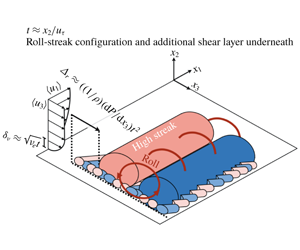Crossref Citations
This article has been cited by the following publications. This list is generated based on data provided by
Crossref.
Meneveau, Charles
2020.
A note on fitting a generalised Moody diagram for wall modelled large-eddy simulations.
Journal of Turbulence,
Vol. 21,
Issue. 11,
p.
650.
Abe, Hiroyuki
2020.
Direct numerical simulation of a non-equilibrium three-dimensional turbulent boundary layer over a flat plate.
Journal of Fluid Mechanics,
Vol. 902,
Issue. ,
Chen, Jianqiang
Dong, Siwei
Chen, Xi
Yuan, Xianxu
and
Xu, Guoliang
2021.
Stationary cross-flow breakdown in a high-speed swept-wing boundary layer.
Physics of Fluids,
Vol. 33,
Issue. 2,
Zhou, Zhideng
He, Guowei
and
Yang, Xiaolei
2021.
Wall model based on neural networks for LES of turbulent flows over periodic hills.
Physical Review Fluids,
Vol. 6,
Issue. 5,
Xu, Haosen H. A.
Yang, Xiang I. A.
and
Milani, Pedro M.
2021.
Assessing Wall-Modeled Large-Eddy Simulation for Low-Speed Flows with Heat Transfer.
AIAA Journal,
Vol. 59,
Issue. 6,
p.
2060.
Lv, Yu
Huang, Xinyi L. D.
Yang, Xiaolei
and
Yang, Xiang I. A.
2021.
Wall-model integrated computational framework for large-eddy simulations of wall-bounded flows.
Physics of Fluids,
Vol. 33,
Issue. 12,
Yang, Xiang I.
Xu, Haosen
and
Milani, Pedro
2021.
Wall-modeled Large-eddy Simulations of Low-speed Flows with Heat Transfer.
Cho, Minjeong
Lozano-Durán, Adrián
Moin, Parviz
and
Ilhwan Park, George
2021.
Wall-Modeled Large-Eddy Simulation of Turbulent Boundary Layers with Mean-Flow Three-Dimensionality.
AIAA Journal,
Vol. 59,
Issue. 5,
p.
1707.
Menter, Florian
Hüppe, Andreas
Matyushenko, Alexey
and
Kolmogorov, Dmitry
2021.
An Overview of Hybrid RANS–LES Models Developed for Industrial CFD.
Applied Sciences,
Vol. 11,
Issue. 6,
p.
2459.
Hao, Xuanting
and
Shen, Lian
2022.
Large-eddy simulation of gusty wind turbulence over a travelling wave.
Journal of Fluid Mechanics,
Vol. 946,
Issue. ,
Fowler, Mitchell
Zaki, Tamer A.
and
Meneveau, Charles
2022.
A Lagrangian relaxation towards equilibrium wall model for large eddy simulation.
Journal of Fluid Mechanics,
Vol. 934,
Issue. ,
Di Renzo, Mario
Oberoi, Nikhil
Larsson, Johan
and
Pirozzoli, Sergio
2022.
Crossflow effects on shock wave/turbulent boundary layer interactions.
Theoretical and Computational Fluid Dynamics,
Vol. 36,
Issue. 2,
p.
327.
Deskos, Georgios
Ananthan, Shreyas
and
Sprague, Michael A.
2022.
Direct numerical simulations of turbulent flow over misaligned traveling waves.
International Journal of Heat and Fluid Flow,
Vol. 97,
Issue. ,
p.
109029.
Lav, Chitrarth
Sandberg, Richard D.
Tanimoto, Koichi
and
Terakado, Kiyoshi
2022.
Momentum boundary-layer characterisation from a pulsed impinging jet.
International Journal of Heat and Fluid Flow,
Vol. 94,
Issue. ,
p.
108918.
Lozano-Durán, Adrián
Bose, Sanjeeb T.
and
Moin, Parviz
2022.
Performance of Wall-Modeled LES with Boundary-Layer-Conforming Grids for External Aerodynamics.
AIAA Journal,
Vol. 60,
Issue. 2,
p.
747.
Zhao, Wei-wen
Pan, Zhi
Yu, Lian-jie
and
Wan, De-cheng
2022.
An overview of flow field computational methods for hydrodynamic noise prediction.
Journal of Hydrodynamics,
Vol. 34,
Issue. 6,
p.
994.
Deshpande, Rahul
Zampiron, Andrea
Chandran, Dileep
Smits, Alexander J.
and
Marusic, Ivan
2023.
Near-Wall Flow Statistics in High-$$Re_{\tau }$$ Drag-Reduced Turbulent Boundary Layers.
Flow, Turbulence and Combustion,
Chen, Peng E.S.
Wu, Wen
Griffin, Kevin P.
Shi, Yipeng
and
Yang, Xiang I.A.
2023.
A universal velocity transformation for boundary layers with pressure gradients.
Journal of Fluid Mechanics,
Vol. 970,
Issue. ,
Fowler, Mitchell
Zaki, Tamer A.
and
Meneveau, Charles
2023.
A multi-time-scale wall model for large-eddy simulations and applications to non-equilibrium channel flows.
Journal of Fluid Mechanics,
Vol. 974,
Issue. ,
Vadrot, Aurélien
Yang, Xiang I. A.
and
Abkar, Mahdi
2023.
Survey of machine-learning wall models for large-eddy simulation.
Physical Review Fluids,
Vol. 8,
Issue. 6,





